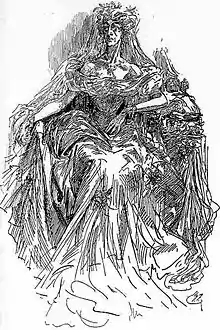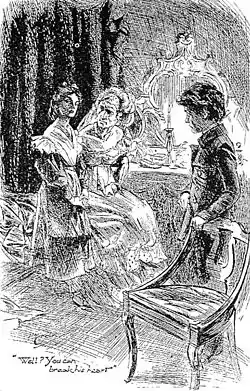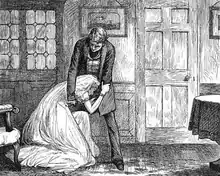Miss Havisham
Miss Havisham is a character in the Charles Dickens novel Great Expectations (1861). She is a wealthy spinster, once jilted at the altar, who insists on wearing her wedding dress for the rest of her life. She lives in a ruined mansion with her adopted daughter, Estella. Dickens describes her as looking like "the witch of the place".
| Miss Havisham | |
|---|---|
| Great Expectations character | |
 Miss Havisham, by Harry Furniss | |
| Created by | Charles Dickens |
| Portrayed by | Gillian Anderson Anne Bancroft Helena Bonham Carter Joan Hickson Martita Hunt Margaret Leighton Charlotte Rampling Florence Reed Jean Simmons Tabu Tuppence Middleton |
| In-universe information | |
| Gender | Female |
| Occupation | Heiress Recluse |
| Family | Arthur Havisham (half brother) |
| Children | Estella (adoptive daughter) |
| Relatives | Pocket family (cousins) Cousin Raymond Georgiana Camilla Bentley Drummle (son-in-law) |
| Nationality | British |
Although she has often been portrayed in film versions as very elderly, Dickens's own notes indicate that she is only in her mid-thirties at the start of the novel. However, it is indicated in the novel that her long life without sunlight has aged her.
Character history
Miss Havisham's father was a wealthy brewer and her mother died shortly after she was born. Her father later remarried and had a son, Arthur, with the household cook. Although they grew up together, Miss Havisham's relationship with her half-brother was not harmonious. She inherited most of her father's fortune and fell in love with a man named Compeyson, who conspired with the jealous Arthur to swindle her of her riches. Her cousin, Matthew Pocket, warned her to be careful, but she was too much in love to listen. On the wedding day, while she was dressing, Miss Havisham received a letter from Compeyson and realised he had defrauded her and she had been left at the altar.

Humiliated and heartbroken, Miss Havisham suffered a mental breakdown and remained alone in her decaying mansion Satis House – never removing her wedding dress, wearing only one shoe, leaving the wedding breakfast and cake uneaten on the table, and allowing only a few people to see her. She even had the clocks in her mansion stopped at twenty minutes to nine: the exact time when she had received Compeyson's letter.
Time passed and Miss Havisham had her lawyer, Mr. Jaggers, adopt a daughter for her.
I had been shut up in these rooms a long time (I don't know how long; you know what time the clocks keep here), when I told him that I wanted a little girl to rear and love, and save from my fate. I had first seen him when I sent for him to lay this place waste for me; having read of him in the newspapers, before I and the world parted. He told me that he would look about him for such an orphan child. One night he brought her here asleep, and I called her Estella.
From protection to revenge
While Miss Havisham's original goal was to prevent Estella from suffering as she had at the hands of a man, it changed as Estella grew older:
Believe this: when she first came, I meant to save her from misery like my own. At first I meant no more. But as she grew, and promised to be very beautiful, I gradually did worse, and with my praises, and with my jewels, and with my teachings, and with this figure of myself always before her a warning to back and point my lessons, I stole her heart away and put ice in its place.
While Estella was still a child, Miss Havisham began casting about for boys who could be a testing ground for Estella's education in breaking the hearts of men as vicarious revenge for Miss Havisham's pain. Pip, the narrator, is the eventual victim; and Miss Havisham readily dresses Estella in jewels to enhance her beauty and to exemplify all the more the vast social gulf between her and Pip. When, as a young adult, Estella leaves for France to receive education, Miss Havisham eagerly asks him, "Do you feel you have lost her?"
Repentance and death

Miss Havisham repents late in the novel when Estella leaves to marry Pip's rival, Bentley Drummle; and she realises that she has caused Pip's heart to be broken in the same manner as her own; rather than achieving any kind of personal revenge, she has only caused more pain. Miss Havisham begs Pip for forgiveness.
Until you spoke to [Estella] the other day, and until I saw in you a looking-glass that showed me what I once felt myself, I did not know what I had done. What have I done! What have I done!
After Pip leaves, Miss Havisham's dress catches on fire from her fireplace. Pip rushes back in and saves her. However, she has suffered severe burns to the front of her torso (she is laid on her back), up to the throat. The last words she speaks in the novel are (in a delirium) to Pip, referencing both Estella and a note she, Miss Havisham, has given him with her signature: "Take the pencil and write under my name, 'I forgive her!'"
A surgeon dresses her burns, and says that they are "far from hopeless". However, despite rallying for a time, she dies a few weeks later, leaving Estella as her chief beneficiary, and a considerable sum to Herbert Pocket's father, as a result of Pip's reference.
Claimed prototypes
Eliza Emily Donnithorne (1821–1886) of Newtown, Sydney, was said to have been jilted by her groom on her wedding day and spent the rest of her life in a darkened house, her rotting wedding cake left as it was on the table, and with her front door kept permanently ajar in case her groom ever returned. She was widely considered at the time to be Dickens' model for Miss Havisham, although this cannot be proven.[1]
In the 1965 Penguin edition, Angus Calder notes at Chapter 8 that "James Payn, a minor novelist, claimed to have given Dickens the idea for Miss Havisham – from a living original of his acquaintance. He declared that Dickens's account was 'not one whit exaggerated'."[2] It is documented Dickens encountered a wealthy recluse called Elizabeth Parker on whom it is widely believed he based the character, whilst staying in Newport, Shropshire, at the aptly named Havisham Court.[3]
Alternative versions
Miss Havisham's Fire (1979, revised 2001) is an opera composed by Dominick Argento with a libretto by John Olon-Scrymgeour, based on Dickens' character. The entire story is told in flashback during an inquiry into Miss Havisham's death. The opera gives her first name as "Aurelia".
Miss Havisham is a major character in the comic detective/mystery series of novels featuring Thursday Next by Jasper Fforde. The stories are set in a fantasy/alternate universe milieu, in which characters borrowed from classic literature play a prominent role.
Ronald Frame's 2013 novel, Havisham, is a non-canonical story about Miss Havisham's early life. The story tells how Miss Havisham (given the name of Catherine) is the daughter of a brewer. The story tells of more than just the infamous trauma of being left behind by her fiancé and goes on with her taking charge of her family's business before descending into vengeful madness, adopting Estella, and arranging the meeting of Estella and Pip.
A young version of Miss Havisham is portrayed by Tuppence Middleton in the 2015 BBC TV series Dickensian. The series gives her the first name Amelia and references the period of her life in the months running up to her wedding. Satis House is relocated to London within the same community as other characters from novels by Dickens.
In film and television
In film adaptations of Great Expectations, Miss Havisham has been played by a number of actors, including:
- Florence Reed (1934)
- Martita Hunt (1946)
- Margaret Leighton (1974)
- Joan Hickson (1981)
- Jean Simmons (who had previously played Estella in 1946 opposite Hunt) (1989)
- Anne Bancroft (1998) (a version which modernised the story to the twentieth century and changed the names of several characters)
- Charlotte Rampling (1999)
- Gillian Anderson (2011, 3-part TV movie adaptation)[4][5][6]
- Helena Bonham Carter (2012) (in this version the character is given the first name "Eleanor" but no one addresses her by it)
- Tuppence Middleton (2015) (in the multiplot TV series Dickensian; in this version the character is given the first name "Amelia" and referenced as such)
- Tabu (2016) (in Fitoor, a Hindi version; as Begum Hazrat)
- Mentioned in 'P.S. I Love You' (2007)
- Mentioned in the sixth episode of the third season of the TV show 'Supernatural' (2005-2020)
Characters inspired by Miss Havisham
Both Sunset Boulevard and What Ever Happened to Baby Jane? were inspired by David Lean's adaptation of Great Expectations, as were, by extension, the characters of Norma Desmond and Baby Jane Hudson, and their homes.[7]
In science
The condition of the "Miss Havisham effect" has been coined by scientists to describe a person who suffers a painful longing for lost love, which can become a physically addictive pleasure by activation of reward and pleasure centres in the brain, which have been identified to regulate addictive behaviour – regions commonly known to be responsible for craving and drug, alcohol and gambling addiction.[8][9][10]
References
- Ryan, J. S. "Donnithorne, Eliza Emily (1826–1886)". Australian Dictionary of Biography. Canberra: National Centre of Biography, Australian National University.
- Dickens, Charles (1861). Calder, Angus (ed.). Great Expectations (1965 ed.). New York City: Penguin Books. ISBN 978-0393960693.
- Kasprzak, Emma (11 January 2012). "Dickens bicentenary: Shropshire celebrates links". BBC News. London, England: BBC. Retrieved 30 June 2018.
- "BBC One – Great Expectations – Miss Havisham". Bbc.co.uk. 1 January 1970. Retrieved 14 August 2012.
- Osborn, Michael (24 December 2011). "BBC News – Great Expectations: Miss Havisham given 'youthful' air". Bbc.co.uk. Retrieved 14 August 2012.
- Gillian Anderson. "TV blog: Great Expectations: Falling in love with Miss Havisham". BBC. Retrieved 14 August 2012.
- Mazur, Matt (5 January 2011). "The Devil is a Woman: Sunset Boulevard, Norma Desmond, and Actress Noir". International Cinephile Society. Retrieved 30 June 2018.
- O'Connor, Mary-Frances; Wellisch, David K.; Stanton, Annette L.; Eisenberger, Naomi I.; Irwin, Michael R.; Lieberman, Matthew D. (15 August 2008). "Craving love? Enduring grief activates brain's reward center". NeuroImage. 42 (2): 969–972. doi:10.1016/j.neuroimage.2008.04.256. PMC 2553561. PMID 18559294.
- Perry, Keith (28 June 2008). "Pining for lost love can be physically addictive". The Daily Telegraph. London, England: Telegraph Media Group. Retrieved 25 March 2014.
- Selway, Jennifer (1 December 2012). "Charles Dickens' greatest heroine". Daily Express. London, England: Trinity Mirror. Retrieved 25 March 2014.
External links
| Wikimedia Commons has media related to Miss Havisham. |